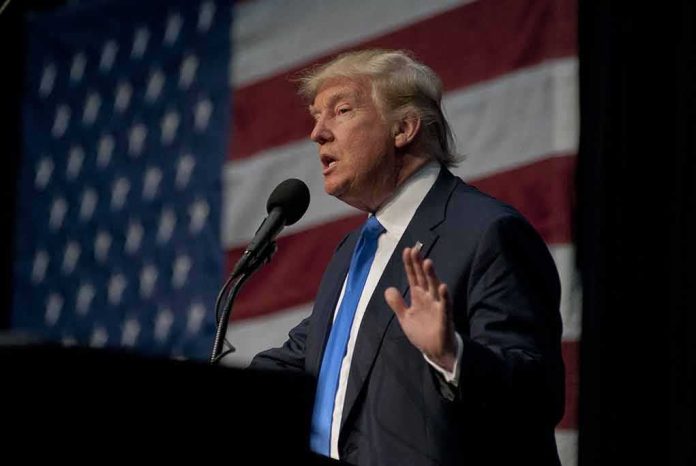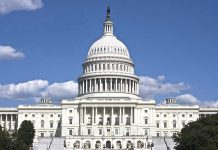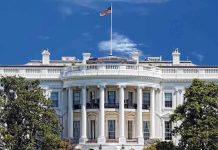
The federal government’s shutdown has become a weapon of unprecedented precision, with President Trump freezing nearly $28 billion in funding that overwhelmingly targets Democratic-controlled cities and states, revealing a calculated strategy that transforms budget disputes into political warfare.
Story Snapshot
- Trump administration froze or canceled $28 billion in federal funding, primarily affecting Democratic strongholds
- New York City lost $18 billion for infrastructure projects, while Chicago saw $2.1 billion frozen
- Green energy initiatives across 16 states had $7.5 billion terminated during the shutdown
- Administration justified cuts by citing concerns over race-based contracting and DEI principles
- Senate failed to pass funding bills as the shutdown extended into its 15th day
Political Precision in Federal Spending Cuts
The Trump administration’s funding freeze represents a departure from traditional government shutdowns. Rather than implementing across-the-board spending reductions, the White House has surgically targeted specific projects in Democratic territories. The Department of Transportation paused $18 billion designated for New York City infrastructure on October 1, 2025, citing objections to race-based contracting practices. This strategic approach demonstrates how budget authority can be wielded as a political instrument, transforming what was once a blunt tool of fiscal policy into a precision-guided mechanism for advancing partisan objectives.
OMB Director Russ Vought has played a central role in executing these funding cuts, working directly with the president to identify and halt projects deemed wasteful or politically motivated. The administration’s rationale centers on eliminating programs that allegedly violate constitutional principles or promote what they characterize as excessive diversity initiatives. Chicago’s $2.1 billion in frozen infrastructure funding exemplifies this pattern, where major urban centers controlled by Democratic leadership face disproportionate financial consequences during the shutdown standoff.
Green Energy Projects Face Systematic Termination
Beyond infrastructure, the administration has targeted the renewable energy sector with particular vigor. Across 16 states, $7.5 billion in green energy funding has been terminated, representing a significant blow to environmental initiatives that gained momentum under previous administrations. These cuts align with the broader conservative skepticism toward federal climate spending and renewable energy subsidies. The targeted nature of these terminations suggests a deliberate effort to reshape federal energy policy through the leverage provided by the shutdown, rather than through traditional legislative channels where such changes might face stronger opposition.
The economic implications extend beyond the immediate funding losses. Construction projects face delays, workers encounter job uncertainty, and state governments must recalibrate their budgets to account for missing federal dollars. Local communities dependent on these projects for economic development now confront an uncertain timeline for completion. The ripple effects touch contractors, suppliers, and service providers who built business plans around federal commitments that have suddenly evaporated. This demonstrates how political decisions at the highest levels translate into tangible consequences for working Americans far removed from Washington’s partisan battles.
Constitutional Questions and Legal Challenges Loom
The administration’s stated concerns about race-based contracting and DEI principles provide the legal framework for these funding freezes. However, legal experts question whether the executive branch possesses the authority to unilaterally cancel congressionally appropriated funds based on such objections. The precedent being established raises fundamental questions about the separation of powers and the extent to which a president can redirect or withhold funding that Congress has already authorized. Democratic leaders have signaled potential legal challenges, though the immediate political calculus focuses on negotiating an end to the shutdown rather than pursuing lengthy court battles.
Negotiations Stalled as Political Tensions Escalate
The Senate’s failure to pass funding legislation on October 15 marked the shutdown’s continuation into its 15th day, with no immediate resolution in sight. Democratic leadership, including Senate Majority Leader Chuck Schumer and House Minority Leader Hakeem Jeffries, face pressure to protect funding for their constituents while avoiding the appearance of capitulating to what they characterize as political extortion. The president has expressed satisfaction with the opportunity to eliminate spending he views as wasteful, suggesting that prolonged negotiations serve his broader objective of reducing federal expenditures and challenging Democratic policy priorities.
The political dynamics are complicated by internal Democratic tensions and the approaching election cycle. State and local Democratic officials whose jurisdictions face funding cuts are pressuring their congressional representatives to reach a compromise, even as progressive members of the party resist concessions they view as rewarding bad-faith negotiating tactics. This intraparty conflict weakens the Democratic position while providing the administration with additional leverage. The standoff reveals how modern government shutdowns have evolved from budget disputes into comprehensive tests of political will, where the party willing to endure more pain ultimately shapes the resolution.
Sources:
The Jerusalem Post – Trump Administration Freezes Federal Funding
The White House – Government Shutdown Clock
Democracy Now – Senate Fails to Pass Funding Bill
AOL News – Trump Halted Nearly $28B in Funding













